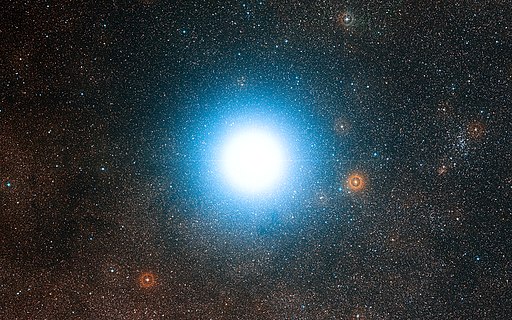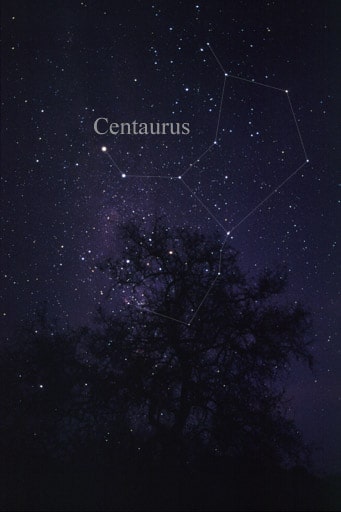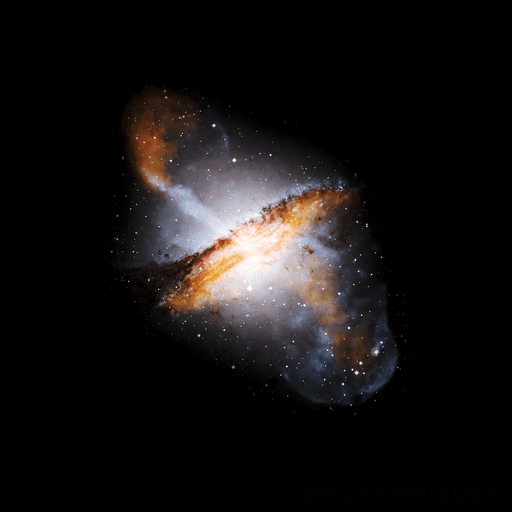Look to the southern hemisphere and you’ll find the Centaurus constellation. The Greek astronomer Ptolemy documented that constellation in the 2nd century. However, earlier Greek texts by the astronomer Eudoxus and the poet Aratus also mention it.
The Centaurus constellation is one of the largest constellations in our night sky. As the name suggests, it represents the half-man, half-horse creature of Greek mythology. Sources across history often disagree on which centaur the Centaurus constellation represents.
However, Chiron is the name by which most refer to the constellation. Chiron is a legendary centaur in Greek mythology and a trainer of heroes. He trained similarly legendary heroes like Hercules, Achilles, and Perseus. A lesser-known fact about him is that Chiron is also the son of the evil Titan of Time, Kronos.
Among the top ten brightest stars in the sky are part of the Centaurus stars. Those stars are the Alpha Centauri and Beta Centauri stars. A whole galaxy is also part of this beautiful constellation: Centaurus A.
The globular constellation Omega Centauri is also part of this constellation. One last celestial body is part of it too; the Blue Planetary nebula, otherwise having the name Boomerang Nebula. This nebula also has the name the “Southerner.”
As the ninth largest constellation in the sky, it occupies a whopping 1060 square degrees. You’ll find it easily in the third quadrant of the southern hemisphere (SQ3). If you look at the latitudes of +25 degrees and -90 degrees, you’ll easily see this huge constellation.
Centaurus Constellation Facts
Some facts about Centaurus constellation include its neighboring constellations. Among these are Hydra, Libra, Lupus, and Vela. The Centaurus constellation also belongs to a specific family of constellations. That family is the Hercules family.
Hercules family constellations include Aquila, Hercules (obviously), Hydra, Sagitta, and Scutum. This constellation has no Messier objects, but contains 11 stars with known planets. The brightest star in Centaurus is undoubtedly Alpha Centauri, the fourth brightest star in the sky.
It’s followed closely by Beta Centauri, tenth brightest star in the sky and second brightest of the Centaurus constellation stars. There are also three meteor showers associated with the Centaurus constellation. These are the Alpha Centaurids, Omicron Centaurids, and Theta Centaurids.
Of its eleven stars, eight of them have names. The International Astronomical Union (IAU) approved their names. Their names are: Dofida, Hadar, Menkent, Nyamien, Proxima Centauri, Rigil Kentaurus, Toliman, and Uklun.
Rigil Kentaurus is just another name for Alpha Centauri. It’s really a multiple star system making that brightness, not a single star. Though Alpha Centauri A, its brightest star, is certainly contributing most of that. It’s the fourth brightest star in the night sky, after all.
Distance isn’t that much either. At 4.365 light years distance, the Alpha Centauri star system is rather close to Earth. At least, insofar as most celestial bodies go. In comparison to Arcturus in the constellation Bootes, it is only slightly fainter.
It’s simpler to think of Alpha Centauri A as much like our own Sun. Alpha Centauri A is a yellow-white main sequence star, belonging to the spectral type G2V. Size is nothing to scoff at on this star either; it’s about 10% larger than our Sun. That may not seem like much, but 10% larger than something like the Sun is huge.
Chiron’s Myth
The story of Centaurus constellation has its roots in Greek mythology. We need to understand Centaurus constellation mythology. So first, we have to familiarize ourselves with Chiron. And the Centaurus constellation has its first sightings in Babylon.
Way back then, this constellation’s name was Bison-man, or Mul-gud-alim to the Babylonians. The depiction was of a four-legged bison with the head of a man. Other times, it was a creature with a human head or torso on the rear legs of a bison. It’s association was typically with the Babylonian sun god, Shamash.
As Greek and Roman empires rose, the same constellation went from Bison-man to Centaurus. The centaur was a mythical half-man, half-horse creature. Greeks feared them for their general barbaric behavior and out-of-control revelry, as well as their skill with bows.
Naturally, it’s not entirely clear which centaur the constellation represents. Ovid was a Roman poet who lived at the turn of the first millennium. He believed the centaur in the constellation was Chiron, the wise hero mentor of legend.
Aside from such legends as Achilles and Hercules, he was also a skilled healer. As such, he transferred his skills in medicine to a son of Apollo, named Asclepius. That hero later became the Greek god of medicine. His caduceus (the stick with snakes on it) became the symbol of medicine, which springs from Asclepius, not typically Hermes.
However, other sources claim that Chiron should rather represent the constellation Sagittarius. Chiron is a child of infidelity; his Titan father, Kronos had turned into a horse while seducing a nymph. He’d done it to avoid detection by his wife, Rhea, while he was seducing the nymph Philyra.
Rigil Kentaurus

At a relatively small 4.365 light years away, the Alpha Centauri star is really a multiple star system. Its apparent magnitude is -0.27. Alpha Centauri A is the brightest component in its system; the thing that makes it one of the sky’s brightest.
With a visual magnitude of -0.01, it is the fourth brightest thing in any night sky on Earth. Alpha Centauri A is only slightly fainter than Arcturus, a brighter star in constellation Bootes. However, the Alpha Centauri star system together is brighter than Arcturus.
Alpha Centauri B is another exceptionally bright star in the constellation. As a main sequence star, it belongs to the spectral type K1V, only slightly smaller than our Sun. Its apparent magnitude is 1.33. This star is the 21st brightest star in our sky, just slightly brighter than Regulus in the Leo constellation.
There’s also a red dwarf in the Alpha Centauri system called Proxima Centauri. It forms a visual double with Alpha Centauri AB and gravitationally associates with them too. Its other name is Alpha Centauri C, separated by 2.2 degrees from the binary star.
Centauri C’s spectral class is M5Ve, meaning it’s a sub-dwarf. At 4.24 light years from the Sun, it’s the nearest star in our solar system. Despite this, its magnitude is only 11.05. That means we typically can’t see it with our naked eye.
The name Rigil Kentaurus has its origins in Arabic. In that language, Rijl Qanturis means “the foot of the centaur.” Its other name, Toliman, is also supposedly from the Arabic language. Al-Zulman is its Arabic origin word, meaning “the ostriches.”
Beta Centauri
Beta Centauri is a bit of a different story from Alpha Centauri. Its other names are Hadar and Agena, and it’s much further away. Unlike the relatively close Alpha Centauri at 4 lightyears, Beta Centauri is much further away at 348.83 light years. Agena is a Latin term meaning “the knee.”
Its apparent magnitude is 0.6 and it’s the tenth brightest star in the sky. A whole six places fainter than Alpha Centauri, but nonetheless making the list for top ten brightest stars. In spectral class B1III, its traditional name is also from Arabic.
Hadar is a traditional Arabic word meaning “ground.” Hadar A is its brightest star and a spectroscopic binary itself. Like Alpha Centauri, Beta Centauri is also a multiple star system rather than a singular star.
Interestingly, Hadar A isn’t even one star; it’s two. Two identical stars make up Hadar A and have an orbital period of 357 days. One of the stars is a Beta Cephei variable, a star whose brightness varies because of its surface pulsations. Hadar B is another part that orbits Hadar A’s twins. It takes about 250 days to make its own orbital period.
Theta Centauri
Theta Centauri, or Menkent, is an orange K-type giant. Its spectral class is K0IIIb and the star is 60.9 light years away from us. The star’s magnitude is 2.06. Again, its name is from the Arabic language. Menkent means “shoulder of the centaur” in Arabic and its other name is Haratan.
Gamma Centauri
As a binary star, Gamma Centauri has two stars that belong to the spectral class A0. Both of the stars have an apparent magnitude of 2.9. It’s a whole 130 light years away from Earth, so it’s a fair distance away from us. Combined, the apparent magnitude of these two stars is 2.2. These two stars orbit each other once every 83 years and they also have the name Muhlifain.
Epsilon Centauri
A blue white giant, Epsilon Centauri is a blue-white giant in spectral class B1III. As a Beta Cephei variable star, it also exhibits variations in brightness because of surface pulsations. Its mean apparent magnitude is 2.29. However, its brightness varies between 2.29 to 2.31 magnitudes. This star system is also 380 light years away, much more distant than Gamma or Alpha Centauri.
Centaurus A
On top of star systems, there are several deep space objects that are part of Centaurus. Among them is Centaurus A, also having the name NGC 5128. It’s the fifth brightest galaxy in the sky and one of the closest radio galaxies to our solar system.
Either a lentical or giant elliptical galaxy, it’s a whole 10 to 16 million light years away. You would take 10 to 16 million years to get there if you move at the speed of light. And the speed of light is nothing to scoff at: 299.7 million meters per second.
Centaurus A’s has an apparent magnitude of 6.84 and many believe it has a black hole in its center. At the moment, people believe that Centaurus A is undergoing a collision with another galaxy. That means it’s in the process of devouring that spiral galaxy. The result is an intense burst of star formation in Centaurus A.
More than a hundred star forming regions are observable in Centaurus A’s galaxy disk. We’ve been watching this star system for a long time; since 1986, to be exact. Since that time, we’ve spotted a type Ia supernova forming in that galaxy. That means a white dwarf met its end that year and exploded into a supernova.
One can find Centaurus A at the center of the Centaurus A subgroup of the Centaurus A/M83 Group. Messier 83, or the Southern Pinwheel Galaxy, is in the constellation Hydra. You’ll find it at the center of the other subgroup.
Omega Centauri
You’ll find Omega Centauri to be a globular cluster in Centaurus. You’ll find it 4 degrees south of Centaurus A. This same cluster’s apparent magnitude is 3.7, and it’s 15,800 light years away from us.
This globular cluster orbits the Milky Way Galaxy. It’s one of the brightest, largest globular clusters associated with the Milky Way. What’s more is that the cluster is visible to our naked eyes.
Originally, Ptolemy listed this cluster as a star. Edmond Halley later rediscovered the cluster and listed it as a nebula in 1677. John Frederick William Herschel later recognized it as a cluster in the 1830’s. If you think about it like that, the Omega Centauri took a while to get right.


